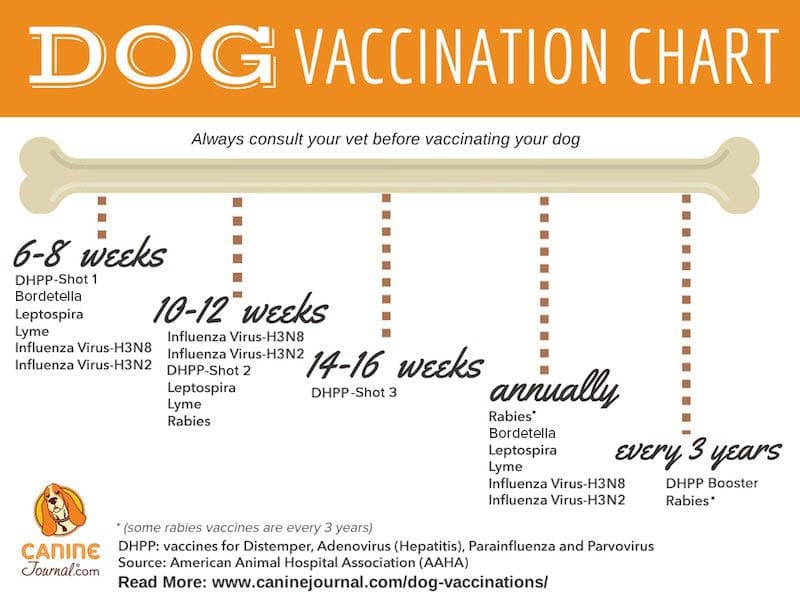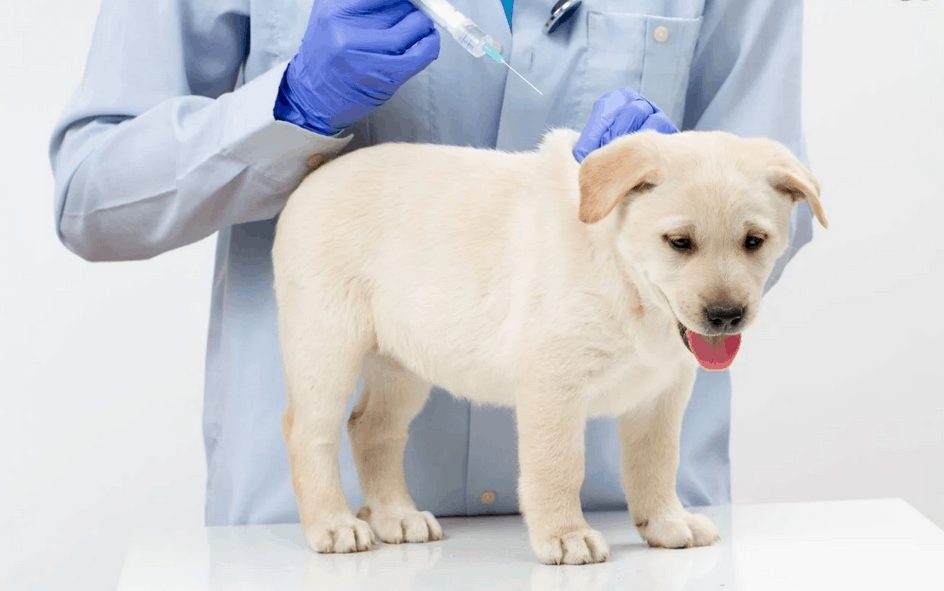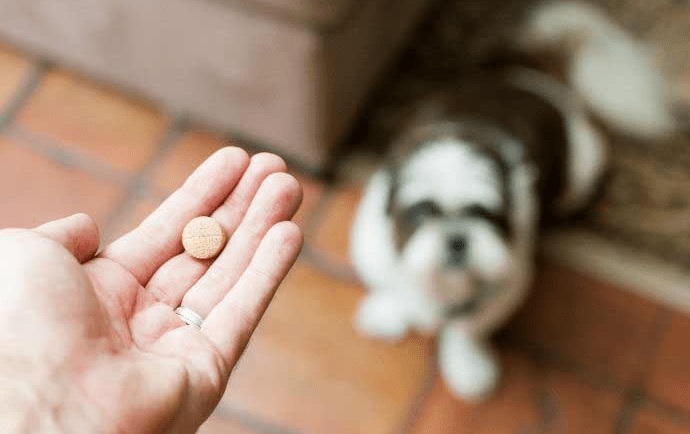The most common vaccines to be given to the dogs are Hepatitis, Canine Distemper, Parainfluenza, Parvovirus, Bordetell, Lyme. These should be administered by a registered vet and you should be present at that time for calming down your dog.
If you thought rabies is a fantasy disease that only happens in movies and TV series, think again.
Your dog can get it — and the same goes for a dozen of other chronic diseases and illnesses that your dog is exposed to.
It’s time you started brushing up on some of these horrifying diseases. It could be the 21st century, but that’s NOT to say it’s NOT possible for your dog to get rabies or any other dog disease on the list such as dog flu.
In Comes Dog Vaccination
If you own a dog, then vaccination is absolutely necessary. Think of it as getting inexpensive health insurance for your dog. It doesn’t matter if your dog spends the whole day wandering outside or is a couch potato who spends the bulk of his day catching a good sleep on the sofa.
Protected as they may be, indoor dogs are still exposed to a long list of infectious diseases, and should, as such, be vaccinated regularly.
How Does Dog Vaccination Work
I) When your dog is being vaccinated against a certain type of virus, what happens is that the dog will be injected with a soupcon dosage of an altered version of the virus itself.
Similar to what happens with human vaccination, the dog will react to the dosage by building up the antibodies that will be working to protect the dog from the virus.
2) The antibodies produced will then circulate the bloodstream. And in doing so, they’ll be protecting the rest of it against the real infection. It’s to be however noted that these antibodies will eventually deteriorate and die.
For this reason, your dog will have to be re-vaccinated or given a booster shot after every year to remain protected.
3) Some of the illnesses your dog is protected from have no cure. Which is to say, should you make the mistake of NOT vaccinating the dog, then you should be prepared to deal with the pain, anxiety, or cost that comes with the dog suffering from any of the aforementioned canine infections?
In other words, most of these diseases have no real treatment, just the prevention of the vaccinations offer.
The primary vaccination your dog will be receiving on a yearly basis is nothing more than a booster shot of the puppy series administered to your dog after six weeks of growth. Otherwise referred to as DHLP/P, this injection is given to about six weeks old puppies three or four times after a spaced interval of three weeks.
And once the puppy matures, he’ll need a single shot of DHLP/P boost per year to remain protected.

Mandatory Diseases For Which Vaccines Should Be Given
In which case, your dog will be given the combination vaccine, basically meant to protect your dog against a string of possible illnesses such as hepatitis, distemper, parainfluenza, and parvovirus to name a few.
1) Viral Hepatitis
Hepatitis affects the liver. And once a dog is infected, he may start to experience a series of symptoms ranging from eye discharge, severe abdominal pains, depression, and a slight fever.
The fever can go from slight to extremely high, lasting for a time stretch of up to six days. Convulsions may ensue after that, further triggering severe bleeding that’s fatal.
Causes:
Dogs get the disease from infected dogs when they shed off the virus in stools and body fluids. Most affected are the young puppies or old dogs with a weak immune system.
2) Canine Distemper Virus
This disease is highly contagious and fatal. Known for affecting the dog’s digestive, respiratory, and nervous system, the virus is common among six months old puppies. However, any dog that’s NOT vaccinated, regardless of age, is likely to be infected.
Once a dog has contacted the virus, the first thing he’ll experience is cold-like symptoms such as sneezing, coughing, lethargy, as well as nose and eye discharge. The dog may also start experiencing some hypersensitivity towards the light. They may also suffer from high fever which lasts for about three days.
The fever will go, only to return a few days later, alongside serious vomiting and diarrhea.
The discharge emanating from the dog’s ears and nose will turn yellow, forcing the dog to lose appetite and weight. Finally, the virus will then proceed to attack the nervous system, causing the dog to shake, pace, and start experiencing seizures.
There’s a slim chance that your dog may recover from all this with proper treatment. But even with this, the dog will be left with a severe nervous disorder that will be seeing to it that he keeps on shaking uncontrollably and that their head remains tilted, in addition to adopting an awkward walking style.
Causes:
Your dog is likely to suffer from distemper after coming in contact, either directly or indirectly, with infected saliva, urine, or any other body fluid.
3) Parainfluenza
Parainfluenza is one of the most dreaded dog diseases, known for attacking the respiratory tract. The disease is highly contagious, which heightens the odds of your dog contacting it should there be any dog within your locality that happens to be suffering from it.
Once a dog is infected, the first thing the dog will experience is a harsh dry cough, followed by a loss of appetite. The dog may also start to experience a running nose and suffer depression altogether.
If nothing is done to treat this symptom or treat the disease on the overall, the dog’s respiratory system will be significantly damaged, making the disease fatal.
Causes:
This disease is common among puppies or young dogs that grow up in weakened environmental conditions.
The disease’s virus is airborne, so cleaning the dog’s kernel or keeping their living environment and living conditions clean isn’t enough to ward off the disease. Meaning, the only way to keep your dog safe from all this is to make sure they’re vaccinated from parainfluenza.
4) Parvovirus
There’s a reason parvovirus is the most dreaded virus among dog owners. And that’s because there’s absolutely zero chance of your puppy ever coming out of it alive once infected.
First, once infected, the puppy will begin by suffering severe bloody diarrhea, triggering lots of vomiting and dehydration. The effects are so intense that the dog has a maximum of three days to live.
Known for attacking puppies between the age of four and eight weeks, the virus will be primarily targeting the puppies heart, thus killing the pup within three days of catching the infection.
Causes:
The parvovirus is spread through body fluids such as saliva, urine, and stool. Once a dog is infected, destroying the virus is the next thing to impossible, something that renders the disease incurable.
That way, the only safe way to ensure your dog stays safe is to make prior arrangements to keep it protected by vaccinating it right on time.
5) Bordetella or Kennel Cough
Meant to protect your dog from kennel cough, it’s highly recommended that you administer the bordetella vaccine every year to your dog to keep it safe.
Even better, the technology behind the vaccine has now advanced such that vets are now administering it intranasally and NOT via an injection as with many of the vaccines you know.
The vaccine will be sprayed into the dog’s nose, NOT injected.
Where a dog is only suffering from bordetella, with no trace of any other infection, the dog will only show a few cough-like symptoms in the gamut of harsh coughing and gagging. At times, the coughing may be accompanied by foamy mucus.
Like the common cold, kennel cough has no cure. It can only be prevented through vaccination. The antibiotic prescribed can also be used to prevent a second infection, parainfluenza, from infecting the dog and further complicating the issue.
The bordetella bacteria is extremely stubborn. Which is to say normal disinfection and cleaning isn’t enough to completely wipe it out. The bacteria is also known for flourishing where your dog is kenneled along many other dogs.
To keep your dog safe, you may be required to vaccine him before he’s exposed to bordetella infected conditions. The grooming service of the dog must also be up to snuff to avoid creating unnecessary complications.
Causes:
Bordetella is an airborne disease. Which is to say, your dog is likely to be infected after inhaling the Bordetella virus or bacteria in the air. The inhaled bacteria will then enter into the respiratory tract, thus inflaming the trachea and larynx.
The condition is also aggravated when the dog is stressed, exposed to cold temperatures, or placed in a poorly ventilated area.
6) Lyme Disease
Another common disease that your dog is exposed to is Lyme. Spread through tick bites, the disease is characterized by lameness and swollen lymph nodes. However, that’s NOT always the case.
If you suspect your dog is suffering from Lyme, the first thing to do is to check the dog for ticks. Where the ticks are NOT gotten rid off, the dog may live to suffer from extreme inflammation in the nervous system, kidney, and heart — each of which can potentially lead to the dog’s death.
Vets can easily diagnose a dog for Lyme by testing out his blood samples. Where the test comes out positive, the illness can be treated by prescribing Doxycycline. However, in the event that the disease has grown to an advanced stage, the dog may be subjected to antibiotic treatment.
However, if you happen to come from an area where the issue of Lyme disease is a major concern, you may want to make prior arrangements to vaccinate the dog. In this case, you’re advised to vaccinate your dog against Lyme when the dog is about eight weeks old, followed by a second dose of the vaccine four weeks later.
That should be followed by a booster shot after about a year, followed by a second shot of the vaccine after four weeks before turning to a yearly shot.
Causes:
Lyme is caused by the spirochete bacteria and transmitted to dogs by the hard-shelled, slow-feeding ticks. Normally, an infected dog will begin experiencing mild symptoms of the Lyme disease after the spirochete carrying bacteria has been attached to your dog for at least 48 hours.
Things to Consider When Vaccinating Your Dog
Core Vaccination
Before you even think of vaccinating your dog, it’s crucial to understand both local and countrywide laws determining which of the vaccinations offered are mandatory.
Any type of vaccination that’s considered mandatory fits in what’s widely referred to as core vaccination. Meaning, you’ll be violating the law should you decide NOT to take your dog for any of them.
The law enforces this type of law to protect dogs or any other animal from extreme illnesses or fatal diseases such as rabies, hepatitis virus, canine distemper or canine parvovirus.
Such a measure is also meant to protect the public from getting infected by any of the diseases should they accidentally get bit by a dog.
So where a rabies-infected dog bites someone, and it happens that the dog wasn’t vaccinated for rabies, then the victim has the right to sue the dog owner and get compensated for the damages done.
Non-core Vaccination
This is where you vaccinate your dog to keep him safe from some of the common ailments and diseases. The law doesn’t hold you to it unless the disease is thought to be rampant within that particular region.
A common example is the canine parainfluenza vaccination. You may find it fit to administer the vaccine to your dog for the simple reason that it’s the only way to keep your dog safe from the virus.
Meaning, it’s upon you to decide on whether or NOT you want to vaccine your dog. And should you decide NOT to, there are no legal implications to haunt you for the decision you make.

Factors to Consider when administering Non-core Vaccinations
Core vaccines are mandatory and that’s pretty much like it. You have no option but to get your dog vaccinated against some core diseases and illnesses that have been identified by the authorities in charge.
Non-core vaccinations, on the other hand, are your own personal choice. But before you jump at the decision, there are certain elements that do come in play, and which determine which non-core vaccination is well suited with your dog.
This includes things like the age of your dog, its size, allergies, or overall health conditions. Also important is for you to know the vaccination history of the dog or a list of all the vaccinations that the dog has been receiving through time.
1. Vaccinating a dog that’s too old or too Young is Risky to the Dog’s life
Every vaccine comes with a minimum age requirement that restricts dogs of a certain age from receiving the vaccine. Younger puppies that are yet to develop a fully functioning immune system are top among those that the vaccinations have been prohibited from.
Old dogs are also likely to be affected by a vaccination shot as they tend to have a weakened immune system.
Some of these vaccines have some side effects that may be too intense for younger or older dogs to handle.
When you look at it, vaccines are nothing more than a suppressed shot of the diseases in question. They’re basically meant to spark the immune system to generate the much-needed antibodies to counter the identified disease and keep the dog protected from it.
But where the immune system is compromised or weakened, the same shots can be of great danger to the dog itself.
2. How Many Vaccines Must you Administer to a Dog
Don’t administer too much of the vaccines to your dog at a go. This is bound to have adverse effects on your dog’s life.
Also, the combined side effects associated with the vaccines may be too much to wear the dog out. In this case, you may want to begin by spacing out the different vaccines.
Your priority should be with core vaccines while giving your vet more time to administer non-core vaccines when the effects associated with the other vaccines have worn out.
3. The size of your Dog
The size of your dog is of utmost concern whenever you’re thinking of vaccinating him for anything.
First, start by ensuring that your dog is healthy enough and that he has the strength and the much-needed weight to handle the vaccine without creating unnecessary complications.
If your dog is malnourished, due to the runts in his litter or any form of the disease, simple logic demands that you wait for the dog to regain its weight before administering the vaccine to him.
4. Is the dog allergic to any of the ingredients in the vaccine?
Go through the ingredients in the vaccines and single out all the ingredients you suspect your dog is allergic to. Where there’s one, ask your vet for the vaccine alternative or if there’s any way to postpone the vaccination.
In some cases, the vet may be forced to skip the vaccination altogether.
5. What breed is your dog?
Just because dogs are known to suffer from a certain disease or illness that doesn’t mean that your dog is the next one in line. For all we know, certain breeds are more prone to certain diseases and ailments than others.
It’s therefore important that you begin by finding out which diseases your dog is prone to and which one he’s totally safe from.
The same goes for the vaccines in question. As you’re soon to find out, certain breeds of dogs are more sensitive to certain elements of the vaccine, whereas some aren’t.
Examples include the German Shepherd which tends to be hypersensitive to Ivermectin. As it goes, this is due to the presence of MDR1 gene which also tends to affect other herding dogs as well, including the Australian shepherd, Shetland sheepdog, English shepherd, old English sheepdog or any other breed of dog that happens to be a mixture of any of these breeds.
6. The Vaccination History of Your Dog
Where a dog is known for suffering a negative effect caused by any of the vaccines, your vet should be notified for advice or if there’s a possibility of skipping the vaccine without causing unnecessary harm to the dog.
If the effects are more than the dog can handle, then the vet may decide NOT to administer the vaccine or figure out an alternative.
7. The Overall Health of Your Dog
It’s common sense NOT to vaccinate your dog when he’s ill. For all we know, some of the vaccinations administered may put a strain on the overall health of the body and immune system, thus further aggravating the condition or stirring a series of other complications.
Also, where your dog is on the verge of recovering from any disease or illness, make a point NOT vaccinate him until he’s fully recovered and in perfect health to handle the effects of the vaccine.

Source: CanineJournal.com
Conclusion
Every dog owner has at some point wondered if vaccinations are truly necessary. Or perhaps you’ve been having a hard time giving in to the idea of putting your dog under unnecessary pressure and discomfort.
Some people argue in favor of vaccinating your dog for the simple reason that it puts your mind at ease, while a certain group will be quick to question its utility, with some even going ahead to warn you against the possible dangers of vaccinating your dog.
While all sentiments carry weight, it’s always wise to follow the advice of your vet. Where your vet thinks vaccinating your dog is necessary, then you’ll have to take them to advise as is and have your dog vaccinated, unless otherwise.
References
- https://jcm.asm.org/content/33/1/110.short
- https://avmajournals.avma.org/doi/abs/10.2460/javma.2002.221.1401
Table of Contents



